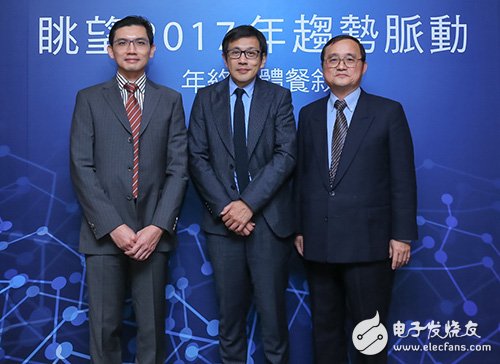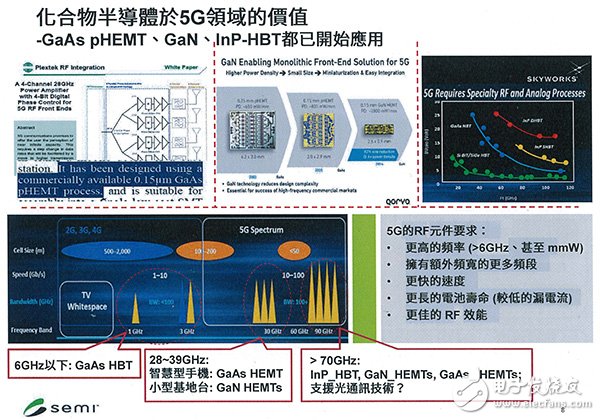Compound semiconductors are a very large concept, and generally refer to various semiconductor components using three-five (III-V), two-six (II-VI) and four-quad (IV-VI) compound materials. Compound materials have many properties different from traditional semiconductor materials such as silicon and germanium. The most well-known properties are direct bandgap and operation at ultra-high frequencies. In addition, some compound materials have high energy conversion efficiency. For example, in the field of power chips, revolutionary gallium nitride (GaN) and silicon carbide (SiC) are classified into three-five and four-six semiconductors (Fig. 1). .

Figure 1 There are many types of compound semiconductors, and the application range is extremely broad. (Data source: SEMI)
The emergence of compound semiconductors is extremely important for the expansion of semiconductor applications. Before the maturity of compound materials, the most important application of semiconductor components is various memory, processor or logic components. However, as compound materials mature, RF, sensing and optoelectronic components have become a force to be reckoned with in the semiconductor industry. It has also caused great disruption in the fields of communication and lighting. However, the capability of compound semiconductors is not only that, but the fields of automobiles and energy will also change dramatically due to the maturity of compound semiconductors.
Compound materials, 18 martial artsDirect energy gap is one of the most well-known and most mature features of compound semiconductor materials. A material with a direct energy gap, when electrons are transferred from a conductive strip to a valence band, most of the energy is released in the form of light, while the silicon material belonging to the Indirect Bandgap is different. Most of the energy is released in the form of heat, and only a small part is converted into light. Therefore, the direct energy gap is closely related to the emergence of various optoelectronic semiconductors. From the most mature light-emitting diodes (LEDs) to the laser sources and sensors used in optical communication, they are applications of direct energy gap characteristics.
As for the ultra-high operating frequency, compound semiconductors also have the characteristics that silicon is difficult to compare. Taking RF applications as an example, the progress of compound semiconductors has always played a pioneering role in the process of continuing to high frequency development in the frequency bands used in wireless communications. For example, when 802.11a technology was just commercialized and the Wi-Fi communication band was pushed to the early stage of 5 GHz, almost no 5 GHz CMOS RF power amplifier (PA) components were found on the market. Similarly, the current topic of 5G millimeter wave (mmWave) communication, because the communication frequency band falls below 28GHz, 39GHz or even 70GHz, the relevant RF PA components will be the world of compound semiconductors for the foreseeable future.
In the field of power management, two new materials, gallium nitride and silicon carbide, are brewing a revolutionary revolution. Compared to traditional silicon-based power conversion chips, gallium nitride and silicon carbide components not only have higher conversion efficiency, but also contribute to a more compact power system design. It is estimated that in the next few years, GaN components will be expected to be widely used in medium and low power power applications with power output below 400 watts, while SiC components are expected to occupy more than 600 watts of high power market. The Battery Management System (BMS), which includes electric vehicles, the Energy Storage System (ESS), which can be used with renewable energy, and the power supply used in the data center, will be due to gallium nitride and The application of silicon carbide components has a breakthrough in performance.
Optical communication / light sensing development prospects are equally eye-catchingLian Ying Optoelectronics Technology Director Lin Jiafu (Figure 2 right) quoted Strategic AnalyTIcs statistics, indicating that the global compound semiconductor market size in 2015 is about 24 billion US dollars, of which LED is the largest application area, accounting for 50% of the overall compound semiconductor market. More; followed by RF communication components, accounting for more than 40%, the proportion of other applications is extremely low. However, with the rise of applications such as 5G communication and power management, compound semiconductors will perform even better in the fields of optical communication, power management, and light sensing. As for the RF applications that have been growing rapidly for many years, the mobile phone market will gradually Saturation and slow growth, it is estimated that by 2020, the proportion of RF components in the compound semiconductor market will be reduced to 25%.

Figure 2 SEMI Taiwan President Cao Shilun (middle), Lian Ying Optoelectronics Technology Director Lin Jiafu (right) and SEMI Taiwan District Industry Research Senior Manager Zeng Ruizhen (left)
Based on data from SEMI and Strategic AnalyTIcs, by 2020, the overall market size of compound semiconductors will grow significantly to $44 billion, with a compound annual growth rate (CAGR) of 12.9%, which is extremely high compared to the 6.5% CAGR of the overall semiconductor market. Bright eyes. Therefore, whether it is LED, RF or other applications, its market size will grow significantly.
In fact, in addition to the low correlation between LED and communication, the growth of other compound semiconductors is related to the general trend of continuous improvement of data communication traffic. The continuous growth of data traffic has pushed up the demand for data center and mobile network deployment, and it also brings diverse application opportunities for compound semiconductors. In addition to the power systems mentioned above, the laser light source and photo sensor (PhotonDetector) used in fiber-optic communication will also grow significantly.
When it comes to light source applications, vertical cavity surface induced laser (VCSEL) is an important technology that cannot be ignored. VCSELs can be used not only in fiber-optic communications, but also in consumer applications such as proximity sensors, and VCSEL-based proximity sensors are more suitable for sensing three-dimensional space than existing solutions. The development of virtual reality (VR) and augmented reality (AR) is critical.
Grabbing the millimeter wave communication market, compound semiconductors do not letAs for the RF communication field, although the overall market growth momentum is slowing down due to the saturation of smart phones, the millimeter wave communication proposed by 5G is expected to bring about a structural change. 5G brings many new challenges to RF components, such as higher communication frequency bands, wider bandwidth, and lower leakage current to alleviate power consumption and heat dissipation.
The industry generally believes that millimeter waves are a difficult technical level, but Lin Jiafu believes that this may be the case for silicon semiconductors, but for compound semiconductors, the problem is actually not big. At present, the most popular material manufacturing process for PA components below 6 GHz is GaAs HBT; 28 GHz ∼ 39 GHz can be divided into two categories, namely GaAs HEMT for smart phones and GaN HEMT for small base station applications. As for the ultra-high frequency band above 70 GHz, there are various process and material selections such as InP HBT, GaN HEMT, and GaAs HEMT. These are process and material technologies that are already in mass production (Figure 3).

Figure 3 shows the various compound semiconductor materials and processes that can be used to implement millimeter-wave power amplifiers. (Data source: SEMI)
For many years, the wife of a woman, a compound semiconductor, has emergedIn fact, the history of the development of compound semiconductors is not far from silicon semiconductors. Many processes and materials technologies have been brewing for more than 20 years, just because the market size is not as good as that of silicon semiconductors, and it is less concerned by the market.
However, within the semiconductor industry, attention to the development of compound semiconductor technology has never been less. Lin Jiafu recalled that when he chose to enter the compound semiconductor industry 20 years ago, the most important reason was that compound semiconductors could achieve many functions that silicon semiconductors could not achieve, and if these technologies were successfully commercialized, they would have a change in human life. Potential, can be said to be a very dreamy industry.
Of course, the development of the world is not always as expected. Lin Jiafu said a little jokingly: "In the compound semiconductor industry, after 20 years of hard work, the hair is white, and finally I hope that the compound semiconductor will take off." But it is undeniable that compound semiconductors have great potential for development. It can even subvert other traditional industries. For example, in the lighting industry, since the emergence of tungsten light bulbs and fluorescent tubes, lighting equipment has not experienced major technological innovations for decades. But now, LED has completely changed the appearance of the lighting industry, tungsten filament bulbs and fluorescent tubes are about to step down the stage.
The same example happened in the telecommunications industry, and the revolution came earlier. Before the emergence of mobile communication technology, the local telephone business used to be the golden chicken mother that every telecom operator relied on for a living. However, the importance of the local telephone business to the telecom operators has long been worse than before. Mobile communication is the battleground for most telecom operators. .
Semiconductor applications are expanding in the field of SEMI servicesIn view of the increasing market size and importance of compound semiconductors and the application of more applications to the semiconductor industry, SEMI, an industrial organization that provides diversified services for the entire semiconductor industry, has expanded its service range in recent years. Among them, the LED and green energy are inseparable from the compound semiconductor. Together with FlexTech and MEMS & Sensors Industry Group, two major industrial organizations in the field of consolidation of flexible electronics and MEMS sensors, SEMI has further enhanced its capabilities in the electronics industry.
Cao Shilun, president of SEMI Taiwan (in Figure 2), said that semiconductor components have become ubiquitous. The five major innovation industries promoted by the Taiwan government in the near future will bring more applications to the semiconductor market on the existing basis. However, different vertical industries have different requirements for semiconductor solutions. Therefore, SEMI must go beyond traditional semiconductor wafers, IC design, packaging and other traditional fields to compound semiconductors, soft and hard electronics, and sensors. Layout in other categories.
Lin Jiafu said that compound semiconductors have a similar industrial structure to silicon crystal semiconductors, but their members are different. Just as the silicon semiconductor industry chain has a division of functions such as wafer fabrication, equipment, package testing, and IC design, the vertical division of the compound semiconductor industry is the same, but wafer fabrication is called epitaxial growth. However, because the materials are very different, the operators in the silicon crystal industry chain have to enter the compound semiconductor production chain, which has high barriers to entry.
Taiwan has a very complete silicon crystal industry. The ability of industrial communication coordination and integration is also world-class. The industrial platform created by SEMI is one of the main players behind it. After SEMI expanded its services in the compound semiconductor field, Lin Jiafu believes that Taiwan's compound semiconductor industry will have a better communication and coordination platform. This is a great boon for Taiwan's compound semiconductor industry, and it will also allow Taiwan's semiconductor industry to add more strategic chips in the face of the rise of China's peers.
In fact, in addition to LEDs, many compound semiconductor applications are highly regulated because they involve military defense. It is only more difficult for Chinese peers to acquire related technologies than silicon technology. At present, if China wants to fully develop its compound semiconductor industry, it can only rely on its own exploration after it has stepped out of the LED field. However, Taiwan's compound semiconductor industry is not regulated. Whether it is to acquire technology from outside or cooperate with foreign companies, the space is relatively large. This is a major advantage in the development of Taiwan's compound semiconductor industry.
Oil Filter For HONDA
HONDA Oil Filter Replacement,Oil Filter For HONDA Cars,HONDA Car Oil Filter,HONDA Auto Oil Filter
Zhoushan Shenying Filter Manufacture Co., Ltd. , https://www.renkenfilter.com